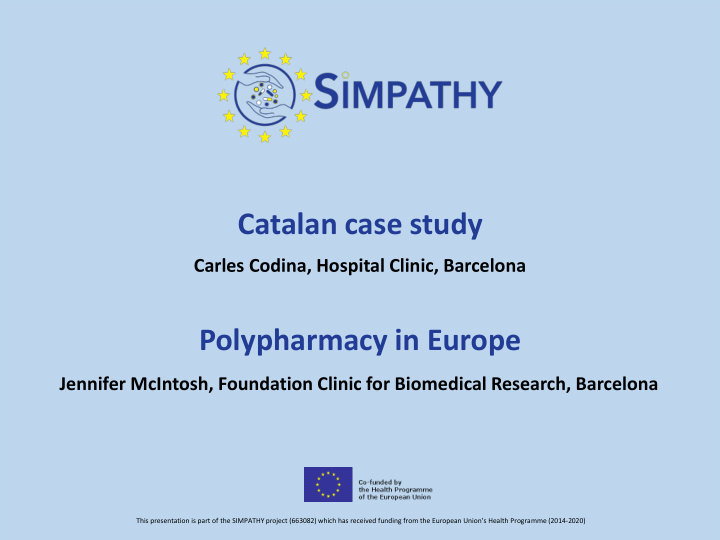



Catalan case study Carles Codina, Hospital Clinic, Barcelona Polypharmacy in Europe Jennifer McIntosh, Foundation Clinic for Biomedical Research, Barcelona This presentation is part of the SIMPATHY project (663082) which has received funding from the European Union’s Health Progra mme (2014-2020) This presentation is part of the SIMPATHY project (663082) which has received funding from the European Union’s Health Progra mme (2014-2020)
Barcelona demographics Life expectancy average 83 years 21,2 % of the Barcelona population is ≥65 years old (N= 342.328) 29,6 % of BCN population ≥65 years old, take ≥5 medicines (N=101.329) 6 % of BCN population ≥65 years old, take ≥ 10 medicines (N=19.111) This presentation is part of the SIMPATHY project (663082) which has received funding from the European Union’s Health Progra mme (2014-2020)
Polypharmacy Initiatives Objectives: • Appropriate patient drug prescription • Patient drug compliance / adherence This presentation is part of the SIMPATHY project (663082) which has received funding from the European Union’s Health Progra mme (2014-2020)
Creating teams and strategic vision • Hospital strategic alliance 2009 Vic (Osona) • Hospital Clinic Barcelona • Consorci Hospitalari de Vic (Osona) Barcelona • Pharmacy department alliance 2009 • Territorial vision Strengths & Opportunities • Hospital Clinic & CH Vic Alliance • Clinical vision & clinical pharmacist • FHSC Vic Patient centered • Strategic plan health care vision • • Strategic alliance departments 2010 Traditional Pharmacy model moving to clinical Pharmacy • Geriatric Department activities • Pharmacy Department • Clinical Pharmacists specialist in • Strategic plan “Patient Centered Prescription” geriatrics • Clinical alliance health care team 2010 • Multidisciplinary health care team • Geriatricians • Clinical pharmacist • Nurses Teaching team Research Team This presentation is part of the SIMPATHY project (663082) which has received funding from the European Union’s Health Progra mme (2014-2020)
Patient Centred Prescription Model Systematic three step process carried out by a geriatrician and a clinical pharmacist 1 Patient-centred assessment ‐ Multidimensional evaluation (clinical, functional, social, cognitive) ‐ Establish therapeutic objectives (survival, maintaining function or symptomatic control) ‐ Shared decision making with patient or care giver Comprehensive ‐ Focus on adherence Geriatric 2 Assessment Diagnosis-centred assessment ‐ List patient health problems-drug-objective ‐ Evaluate applicability of CPG according to patient's care goal. Multidisciplinary 3 Drug-centred assessment team ‐ Assess drugs with high iatrogenic risk ‐ Assess interactions, duplications, adjust drug dose to renal and hepatic function Individualised therapeutic plan This presentation is part of the SIMPATHY project (663082) which has received funding from the European Union’s Health Progra mme (2014-2020)
Interdisciplinary research team ACUTE GERIATRIC UNIT 34,7 – 47,2 % of 66 % reduction of 8,5 % of hospital Risk factors: Extreme patients with drugs in patients admissions polypharmacy (> 10 inappropriate with advanced caused by drugs), anticholinergics, prescribing chronic conditions adverse drug high complexity events INTERMEDIATE CARE NURSING HOMES 74 % of patients with inappropriate prescribing 76 % of patients with inappropriate prescribing 96,5% of patients (STOPP-START) Framework for a with therapeutic Patient plan interventions Centred Prescription Sevilla Sánchez et al. Rev Esp Geriatr Gerontol 2012; Molist et al. Eur Ger Med 2014; Molist et al. Eur Ger Med 2015; Solà Bonada et al. Poster Congreso SEFH. Gijón 2016. Sevilla- Sánchez et al. Eur J Clin Pharmacol 2016. This presentation is part of the SIMPATHY project (663082) which has received funding from the European Union’s Health Progra mme (2014-2020)
Building sustainability Phase 1 – Goal (Hospital Vic Consortium “umbrella”) Hospital Geriatric Unit √ 2010 Other Clinical Units √ Intensity of interventions Long term Hospital – Intermediated Care 2015 Palliative √ Long term √ Review / patients number • Daily review Nursing homes 2015 • Every 2-3 days review Nadal √ ; Aura √ • Weekly review Primary care • Every 2 weeks review 12 health care • 3-4 times per year? 2017 centers In progress √ This presentation is part of the SIMPATHY project (663082) which has received funding from the European Union’s Health Progra mme (2014-2020)
Polypharmacy picture in Europe Scope National Regional No programme Setting Hospital Intermediate / Care homes Primary care Community pharmacy This presentation is part of the SIMPATHY project (663082) which has received funding from the European Union’s Health Progra mme (2014-2020)
Key Stakeholder Messages “We will need to change the dynamic of how we work. If we want to Adding more do this [polypharmacy management] but continue doing the same, work doesn’t well, this will be difficult.” Primary care pharmacist, Catalonia work “One of the most important things is to start Education is ICT is measuring drug use, to get a view of the situation critical but and make healthcare professionals aware of the essential for problem of inappropriate polypharmacy.” inconsistent scaling Geriatrician and policy maker, Sweden “We cannot make an accreditation like Culture can Nothing Northerners based on checklists, that Everything is help or happens in a will never work with us, we are not local hinder vacuum Scottish, dude.” Hospital physician, Portugal This presentation is part of the SIMPATHY project (663082) which has received funding from the European Union’s Health Progra mme (2014-2020)
www.simpathy.eu https://twitter.com/simpathyproject The SIMPATHY project has received funding from the European Union’s Health Programme (2014-2020) This presentation is part of the SIMPATHY project (663082) which has received funding from the European Union’s Health Progra mme (2014-2020)
Recommend
More recommend